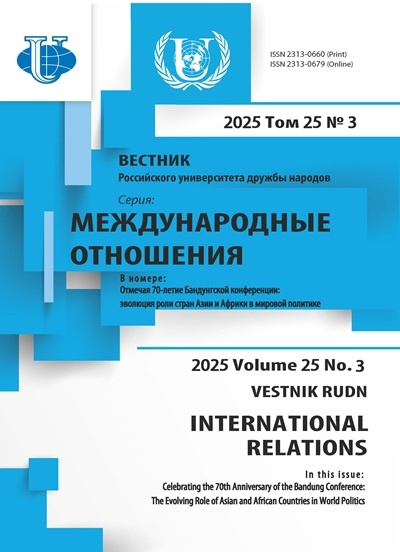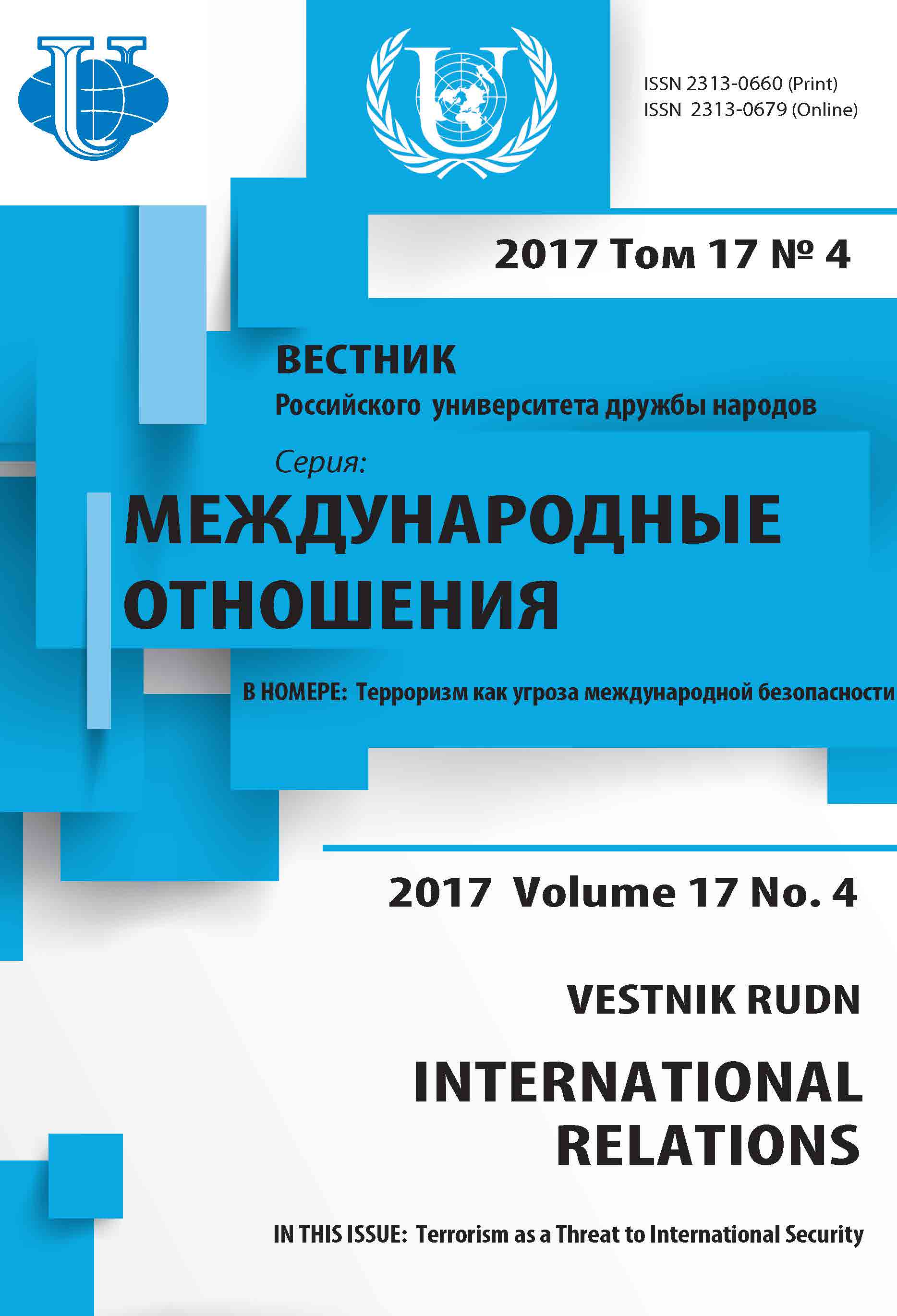УГРОЗА ТЕРРОРИЗМА В СТРАНАХ ЮГО-ВОСТОЧНОЙ АЗИИ
- Авторы: Рогожина НГ1
-
Учреждения:
- Национальный исследовательский институт мировой экономики и международных отношений имени Е.М. Примакова Российской академии наук
- Выпуск: Том 17, № 4 (2017): Терроризм как угроза международной безопасности
- Страницы: 697-709
- Раздел: ТЕМАТИЧЕСКОЕ ДОСЬЕ
- URL: https://journals.rudn.ru/international-relations/article/view/17529
- DOI: https://doi.org/10.22363/2313-0660-2017-17-4-697-709
- ID: 17529
Цитировать
Полный текст
Аннотация
Статья посвящена анализу влияния ИГИЛ (ИГ, «Исламское государство») (запрещено в России) на развитие джихадистского движения в странах Юго-Восточной Азии (ЮВА) с сопутствующим ростом угрозы терроризма в регионе, где проживает 15% мусульман мира и где уже давно действуют террористические организации исламистского толка, вынашивающие планы по созданию здесь салафитского халифата. Выясняются причины уязвимости мусульманских стран ЮВА к распространению идеологии радикального исламизма, что создает предпосылки для вовлечения местных джихадистов в мировое террористическое движение с опасными для стабильности региона последствиями. Создание ИГИЛ представляет непосредственную угрозу для безопасности стран ЮВА, поскольку побуждает к активизации действий местные экстремистские группировки исламистского толка. Все они едины в своем отрицании демократической системы власти, на смену которой должны прийти исламское государство и шариат. Атака на г. Марави (юг Филиппин), предпринятая местными экстремистами, сторонниками ИГИЛ, стала предупреждением для других стран ЮВА об усилении опасности регионализации терроризма в странах Юго-Восточной Азии и превращения региона в новый фронт террористической деятельности группировки ИГИЛ, планирующей создать здесь свой плацдарм. Автор анализирует риски, связанные с усилением интереса к региону ИГИЛ, которое целенаправленно ведет работу по расширению здесь своей социальной базы и мобилизации своих сторонников, рассматривая регион как основной плацдарм по вербовке боевиков в рамках проведе-ния стратегии экспорта терроризма силами «волков-одиночек». В этих целях применяются разные политические инструменты, среди которых наиболее эффективным способом идеологического влияния на местное мусульманское общество становится пропаганда джихада в Интернете. Автор полагает, что создание ИГИЛ способствовало оживлению терроризма в странах ЮВА и появлению множества мелких ячеек такого рода, что повышает уровень террористической угрозы в регионе. Воздействие ИГИЛ на политическую ситуацию в ЮВА проявляется напрямую - в нарастании экстремизма и росте угрозы терроризма - и косвенно - в усилении исламистского радикализма в политическом развитии мусульманских стран.
Ключевые слова
Об авторах
Н Г Рогожина
Национальный исследовательский институт мировой экономики и международных отношений имени Е.М. Примакова Российской академии наук
Автор, ответственный за переписку.
Email: ngrogozhins@mail.ru
Рогожина Наталия Григорьевна - д-р полит. наук, главный научный сотрудник Центра проблем развития и модернизации Национального исследовательского института мировой экономики и международных отношений имени Е.М. Примакова Российской академии наук
Список литературы
- Abuza Z. The Strategic and Tactical Implications of the Islamic State on Southeast Asia’s Militant Groups // Georgetown Journal of Asian Affairs. Fall 2016. P. 20-30. URL: https://asianstudies.georgetown.edu/sites/asianstudies/files/do30cuments/gjaa_3.1_abuza_0.pdf (accessed: 28.08.2017).
- Chan A. The Call of ISIS: The Medium and the Message Attracting Southeast Asians // Counter Terrorist Trends and Analysis. May 2015. Vol. 7. N 4. P. 4-9.
- Disunity Among Indonesian ISIS Supporters and The Risk of More Violence. IPAC Report N 25. Institute for Policy Analysis of Conflict. Jakarta. 1 February 2016.
- Gunaratna R. Islamic State branches in Southeast Asia // Pacific Forum. CSIS. 19 January, 2016. N 7. URL: http:/csis.org/files/publication/160119_PacNet_1607.pdf (accessed: 20.08.2017.
- Gunaratna R. The Siege of Marawi: A Game Changer in Terrorism in Asia // Counter Terrorist Trends and Analyses. Journal of the International Center for Political Violence and Terrorism Research. 2017. Vol. 9. N 7. P. 4-8.
- Hamid A.F.A. Islamic State in Southeast Asia: Internalized Wahhabism Is Major Factor // Eurasia Review Journal. Institute of Southeast Asian Studies. May 18, 2016. URL: http://www.eurasiareview.com/ 18052016-islamic-state-in-southeast-asia-internalized-wahhabism-is-major-factor-analysis/ (accessed 13.08.2017).
- ISIS in the Pacific: Assessing Terrorism in Southeast Asia and the Threat to the Homeland. Testimony before the Subcommittee on Counterterrorism and Intelligence Committee on Homeland Security. United States House of Representatives. April 27, 2016.
- Jayakumar S. The Islamic State Looks East: The Growing Threat in Southeast Asia // CTC Sentinel. 2017. Vol. 10. N 2. P. 27-33.
- Marawi, the ‘East Asia Wilayah’ and Indonesia. IPAC Report N 38. Institute for Policy Analysis of Conflict. Jakarta. 21 July 2017.
- Pro-ISIS Groups in Mindanao and Their Links to Indonesia And Malaysia. IPAC Report N 33. Institute for Policy Analysis of Conflict. Jakarta. 25 October 2016.
- Samuel Th. Radicalization in Southeast Asia. A Selected Case Study of Daesh in Indonesia, Malaysia and The Philippines. The Southeast Asia Regional Centre for Counter-Terrorism (SEARCCT). Ministry of Foreign Affairs. Malaysia, 2016.
- Singh B. Jemaah Islamiyah: Still a Latent Threat // RSIS commentary. S. Rajaranam School of International Studies. N 075. April 24, 2017.
- Snider J. Beyond Performativity: Islamic State (ISIL) and Indonesia’s Counter-radicalization Challenge. Middle East Institute. August 25, 2016. URL: https://www.mei.edu/content/map/ beyond-performativity-islamic-state-isil-and-indonesia (accessed: 24.08.2017).
- The Re-Emergence of Jemaah Islamyah. IPAC Report N 36. Institute for Policy Analysis of Conflict. Jakarta. 27 April 2017.
- Yasin N. The Evolution of Online Extremism in Malaysia // Counter Terrorist Trends and Analyses. A Journal of the International Centre for Political Violence and Terrorism Research. 2017. Vol. 9. N 7. P. 9-14.
Дополнительные файлы










